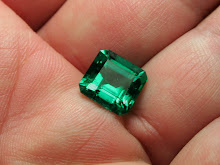 One of the most unique characteristics of an emerald is its inclusions. All emeralds are included, so people accept it, and at times, even value this trait. Inclusions or features within the stone are often referred to as its 'garden'. They are not considered 'a bad thing' unless they negatively impact the stone's integrity or significantly affect its ability to capture, reflect, and manipulate light.
One of the most unique characteristics of an emerald is its inclusions. All emeralds are included, so people accept it, and at times, even value this trait. Inclusions or features within the stone are often referred to as its 'garden'. They are not considered 'a bad thing' unless they negatively impact the stone's integrity or significantly affect its ability to capture, reflect, and manipulate light.
Emeralds with inclusions that would be unacceptable in other gemstones are bought and sold every day at prices well above those of other 'non-included' gems. One has to look at each type of gem as its own distinct, individual species of stone and appreciate the differences, because each gem type is unique.
 Digg
Digg del.icio.us
del.icio.us  Reddit
Reddit  StumbleUpon
StumbleUpon  Fark
Fark  Technorati
Technorati Netscape
Netscape Furl
Furl

